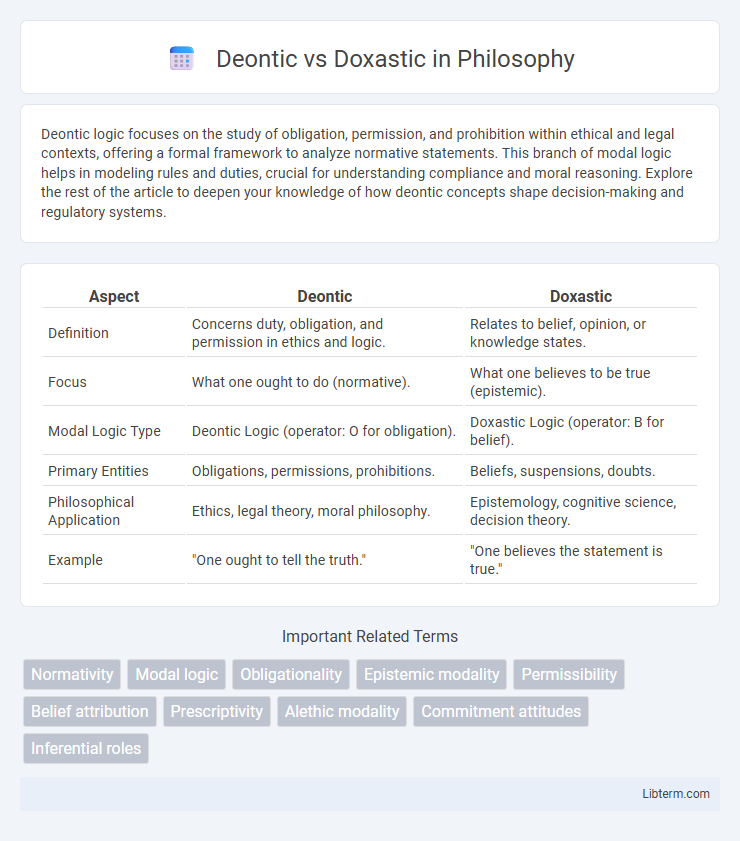Deontic logic focuses on the study of obligation, permission, and prohibition within ethical and legal contexts, offering a formal framework to analyze normative statements. This branch of modal logic helps in modeling rules and duties, crucial for understanding compliance and moral reasoning. Explore the rest of the article to deepen your knowledge of how deontic concepts shape decision-making and regulatory systems.
Table of Comparison
| Aspect | Deontic | Doxastic |
|---|---|---|
| Definition | Concerns duty, obligation, and permission in ethics and logic. | Relates to belief, opinion, or knowledge states. |
| Focus | What one ought to do (normative). | What one believes to be true (epistemic). |
| Modal Logic Type | Deontic Logic (operator: O for obligation). | Doxastic Logic (operator: B for belief). |
| Primary Entities | Obligations, permissions, prohibitions. | Beliefs, suspensions, doubts. |
| Philosophical Application | Ethics, legal theory, moral philosophy. | Epistemology, cognitive science, decision theory. |
| Example | "One ought to tell the truth." | "One believes the statement is true." |
Understanding Deontic and Doxastic: Definitions
Deontic logic deals with normative concepts such as obligations, permissions, and prohibitions, defining what ought to be done according to rules or laws. Doxastic logic, on the other hand, focuses on beliefs and knowledge, representing what agents believe or accept as true. Understanding deontic and doxastic modalities is essential for modeling reasoning in ethical decision-making and epistemic contexts.
The Philosophical Roots of Deontic and Doxastic
Deontic logic, rooted in normative philosophy, examines the nature of obligation, permission, and prohibition, tracing back to Aristotle's ethical theories and Kantian moral imperatives. Doxastic logic, developed within epistemology, analyzes belief states, drawing from Augustine's introspective methods and later formalized by modern philosophers like Hintikka. Both logics formalize modality but diverge as deontic centers on what ought to be, while doxastic centers on what is believed.
Deontic Logic: Norms, Duties, and Permissions
Deontic logic formalizes norms, duties, and permissions, providing a framework to represent and reason about moral and legal obligations. It distinguishes between what agents ought to do (duties) and what they are allowed to do (permissions), using modal operators to capture these normative concepts. This logic is essential in fields such as ethics, legal theory, and artificial intelligence for specifying rules and compliance requirements.
Doxastic Logic: Beliefs, Assumptions, and Epistemic States
Doxastic logic formalizes the representation of beliefs and assumptions, capturing how agents reason about knowledge and uncertainty. It models epistemic states through modalities expressing what an agent believes to be true, enabling the analysis of dynamic information updates and belief revision processes. This logical framework underpins applications in artificial intelligence, game theory, and cognitive science by structuring reasoning about incomplete or possibly incorrect knowledge.
Key Differences Between Deontic and Doxastic Modalities
Deontic modalities relate to permissions, obligations, and prohibitions, governing what is allowed or required within a normative system, while doxastic modalities pertain to beliefs, representing states of knowledge or conviction. Key differences include their respective domains: deontic modality operates in ethical or legal frameworks, whereas doxastic modality functions in epistemic contexts involving belief and knowledge. The semantic operators differ as well, with deontic expressing necessity or possibility tied to social norms, and doxastic expressing epistemic certainty or doubt.
Practical Applications of Deontic and Doxastic Frameworks
Deontic logic, centered on obligation and permission, is widely applied in legal reasoning systems and ethical AI to model normative constraints and enforce compliance with rules. Doxastic logic, dealing with belief and knowledge, plays a crucial role in multi-agent systems and decision-making frameworks where agents' belief states influence actions and strategies. Integrating both frameworks enhances practical applications in autonomous systems, enabling nuanced reasoning about duty-driven actions and belief-informed decisions.
Intersection of Deontic and Doxastic Logic
Deontic and doxastic logic intersect in analyzing the relationship between normative concepts (obligations, permissions) and epistemic states (beliefs, knowledge). This intersection models how agents ought to act based on what they believe, integrating modalities like obligation with belief modalities such as necessity or possibility. Formal systems capturing this interplay provide frameworks for reasoning about rational behavior under uncertainty and normative constraints, essential in areas like artificial intelligence and ethical decision-making.
Challenges in Distinguishing Deontic From Doxastic
Challenges in distinguishing deontic from doxastic modalities arise from their overlapping linguistic expressions and contextual dependencies in natural language. Deontic modality relates to obligation and permission, while doxastic modality pertains to belief and knowledge, making nuanced interpretation critical in fields like formal semantics and artificial intelligence. Ambiguities occur when modal verbs like "must" express both necessity in norms (deontic) and certainty in beliefs (doxastic), complicating computational modeling and pragmatic analysis.
Deontic and Doxastic in Artificial Intelligence
Deontic logic in artificial intelligence focuses on modeling normative concepts such as obligations, permissions, and prohibitions, enabling AI systems to reason about ethical and legal constraints. Doxastic logic, on the other hand, deals with beliefs and knowledge representation, allowing AI agents to infer what is believed or known in uncertain environments. Integrating deontic and doxastic logics enhances AI's capacity to make decisions that align with both moral norms and epistemic states.
Future Directions in Deontic and Doxastic Studies
Future directions in deontic and doxastic studies emphasize integrating formal logic with computational models to enhance ethical decision-making algorithms and belief revision systems. Advances in artificial intelligence encourage the exploration of dynamic modalities within deontic logic to better capture obligations over time and refine doxastic logic frameworks for more accurate belief update mechanisms. Interdisciplinary research combining philosophy, computer science, and cognitive science aims to develop robust models that address normative reasoning and epistemic states in complex, real-world scenarios.
Deontic Infographic

 libterm.com
libterm.com